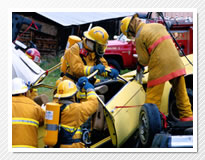Statistics
Source: AAA Foundation for Traffic Safety
- The overwhelming majority (75 percent) of serious teen driver crashes are due to "critical errors," with the three common errors accounting for nearly half of these crashes: lack of scanning that is needed to detect and respond to hazards, going too fast for road conditions (e.g., driving too fast to respond to others or to successfully navigate a curve), and being distracted by something inside or outside of the vehicle.
- Nearly two-thirds of people injured or killed in a crash involving a teen driver are people other than the teen behind the wheel.
- More than one-in-five (21 percent) fatal crashes involve driver fatigue.
- One third of crashes involving a drowsy driver result in injuries and more than 6,000 fatigue-related crashes each year result in at least one fatality.
Source: Accident Analysis and Prevention
- Teen drivers who sleep less than 8 hours nightly are one-third more likely to crash than those who sleep 8 or more hours nightly.
Source: Centers for Disease Control and Prevention (CDC)
- Motor vehicle crashes are the second leading cause of death for U.S. teens.
Source: Insurance Institute for Highway Safety (IIHS)
- In the United States, the fatal crash rate per mile driven for 16-19 year-olds is nearly 3 times the rate for drivers ages 20 and over. Risk is highest at ages 16-17.
- Seventy-eight percent of teenage motor vehicle crash deaths iwere passenger vehicle occupants. The others were pedestrians (9 percent), motorcyclists (5 percent), bicyclists (3 percent), riders of all-terrain vehicles (2 percent) and people in other kinds of vehicles (3 percent).
- 56 percent of deaths among passenger vehicle occupants ages 16-19 were drivers.
- 52 percent of the deaths of teenage passengers in passenger vehicles occurred in vehicles driven by another teenager. Among deaths of passengers of all ages, 14 percent occurred when a teenager was driving.
- Among passenger vehicle drivers ages 16-19 involved in fatal crashes, 47 percent were involved in single-vehicle crashes. This was higher than for drivers ages 25 and older (38 percent).
- June, July, and August have higher teenage crash deaths than other months.
- Fifty-four percent of motor vehicle crash deaths among teenagers occur on Friday, Saturday, or Sunday.
- The fatal crash rate of 16-year-olds is nearly twice as high at night.
Source: Journal of Safety Research
- Although three components of GDL separately contribute to reduced crash rates (extended learner permit period, nighttime driving restrictions, and passenger restrictions), GDL programs that combine all three may result in the highest crash reductions among 16-year-old drivers.
- States with comprehensive GDL programs in place report as much as a 40 percent drop in the number of fatal crashes among 16-year-old drivers.
Source: National Highway Traffic Safety Administration (NHTSA)
- Research shows that seat belts reduce serious crash-related injuries and deaths by about half.
- Driving a vehicle while texting is six times more dangerous than driving while intoxicated.
- 11% of all drivers under 20 involved in fatal crashes were reported as distracted. This age group has the largest proportion of drivers who were distracted.
- Teens have the lowest seat belt use of any age group.
- Speeding increases the stopping distance required to avoid a collision even as it reduces the amount of time a driver needs to avoid a collision (called the 3-second rule). It also increases the likelihood that the crash will result in injury.
Source: National Sleep Foundation
- Drowsiness is similar to alcohol in how it compromises driving ability by reducing alertness and attentiveness, delaying reaction times, and hindering decision-making skills.
- Teens need to log a little more than nine hours of sleep per night to achieve the optimal level of daytime alertness needed to eliminate the risk of drowsy driving.
Source: Virginia Tech Transportation Institute (VTTI)
- Teens are four times more likely to get into a crash or near-crash while distracted than their adult counterparts and teen fatalities are three times greater than adult fatalities.
- Engaging in visual-manual subtasks (such as reaching for a phone, dialing and texting) associated with the use of hand-held phones and other portable devices increased the risk of getting into a crash by three times.
- Five seconds is the average time your eyes are off the road while texting. When traveling at 55mph, that's enough time to cover the length of a football field.
|
|
|
|
